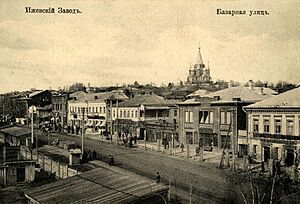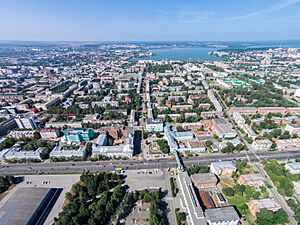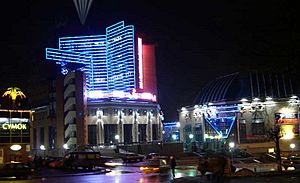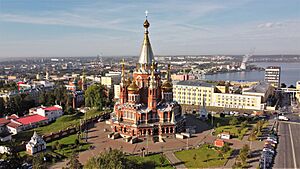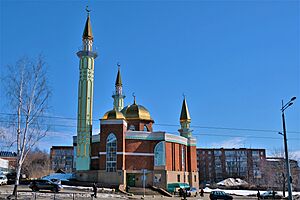Izhevsk facts for kids
Quick facts for kids Izhevsk (English)Ижевск (Russian) Ижкар, Иж (Udmurt) |
|
|---|---|
| - City - | |
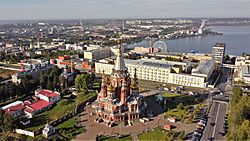 Aerial view of Izhevsk |
|
|
|
|
| City Day | June 12 |
| Administrative status | |
| Country | Russia |
| Federal subject | Udmurt Republic |
| Administratively subordinated to | city of republic significance of Izhevsk |
| Capital of | Udmurt Republic |
| Municipal status | |
| Urban okrug | Izhevsk Urban Okrug |
| Head | Oleg Bekmemetyev |
| Representative body | City Duma |
| Statistics | |
| Area | 315.15 km2 (121.68 sq mi) |
| Population (2010 Census, preliminary) |
627,733 inhabitants |
| - Rank in 2010 | 19th |
| Population (2015 est.) | 642,023 inhabitants |
| Density | 1,992/km2 (5,159/sq mi) |
| Time zone | MSK (UTC+04:00) |
| Founded | April 10, 1760 |
| Postal code(s) |
list
426000, 426003, 426004, 426006–426011, 426015, 426016, 426019, 426021, 426023, 426025, 426027, 426028, 426030, 426032–426036, 426038, 426039, 426041, 426049–426054, 426056–426058, 426060–426063, 426065, 426067–426070, 426072–426077, 426700, 426880, 426890, 426899, 426910, 426960–426965, 426970, 426999, 901009, 901143, 901145, 901147, 993100 |
| Dialing code(s) | +7 3412 |
| Official website: http://www.izh.ru/en/welcome | |
Izhevsk (Russian: Иже́вск, IPA: [ɪˈʐɛfsk]; Udmurt: Ижкар, romanized: Ižkar, or Иж, Iž) is the capital city of Udmurtia, Russia. It sits along the Izh River, west of the Ural Mountains in Eastern Europe. Izhevsk is the 21st-largest city in Russia. It is also the most populated city in Udmurtia, with over 600,000 people living there.
From 1984 to 1987, the city was called Ustinov. It was named after Dmitry Ustinov, a Soviet Minister of Defence. Izhevsk is a major center for industry, business, politics, culture, and education in the Volga Region. It is famous for its industries like defense, engineering, and metalworking. Izhevsk is known as the "Armory Capital of Russia" and the "City of Labor Glory."
Contents
History of Izhevsk
Early Settlements
The first settlements in the area of modern Izhevsk were built by the Udmurt people in the 5th century. There were two strong settlements along the Karlutka River. Later, this land became part of the Khanate of Kazan. In 1552, Russia took over the Khanate. In 1582, Ivan the Terrible gave the lands near the Karlutka and Izh Rivers to Bagish Yaushev, a Tatar noble.
Building the Ironworks
On September 15, 1757, Count Peter Ivanovich Shuvalov bought land in the Kama Region. He got permission from Empress Elizabeth to build three iron factories. Factories back then used wood as fuel. So, one factory was built near the forest-rich Izh River to make iron bands and anchors.
On April 10, 1760, workers from nearby villages started building a dam. This date is seen as the founding day of Izhevsk. Building was slow because the workers were unhappy. In 1762, Shuvalov died. His son Andrey took over the factories. In 1763, Catherine the Great made all of Shuvalov's factories, including the one at Izhevsky Zavod, government property.
By 1763, the dam and ironworks were finished. The first iron was made. The dam created the Izhevsk Reservoir, one of the largest in Europe. A settlement grew near the factory, named Izhevsky Zavod, meaning "the factory on the Izh." The iron from Izhevsky Zavod was used to rebuild the Moscow Kremlin and for construction in Saint Petersburg.
Pugachev's Rebellion and Izhevsk
In October 1773, news of a revolt against Catherine the Great reached Izhevsky Zavod. Yemelyan Pugachev led this revolt, promising freedom to workers. Many workers and artisans supported him. Factory managers had to flee.
On January 1, 1774, Pugachev's army arrived. They destroyed the ironworks and offices. They gave food to the people and freed the workers. Iron production stopped. Catherine sent an army to stop the rebellion. In April 1774, Pugachev's army had to leave Izhevsky Zavod.
However, Pugachev's army returned on June 27, 1774. Crowds cheered for him. He listened to the workers' complaints. Forty-two people, including the former managers, were executed. On June 29, Pugachev left Izhevsky Zavod again. Many workers joined his army. The rebellion was mostly crushed by September 1775. The ironworks was rebuilt and started working again by the end of 1775.
Building an Arms Factory
In 1800, Emperor Paul I wanted an arms factory built in the Urals. This was because of a growing threat from Napoleonic France. Andrew Deryabin, an engineer, chose Izh Zavod as the best place. He thought the ironworks could become an armory.
Alexander I agreed. Construction of the arms factory began on June 10, 1807. This year is seen as Izhevsk's "second birth."
Dudin's City Plan
The new factory needed many workers. People from other factories and new recruits filled the jobs. Skilled armorers came from other arms factories and from Europe. The town grew fast. By 1808, over 6,000 people lived there.
The town was built following a master plan by architect Feodor Dudin. Streets were wide and straight, crossing each other to form neat blocks. In May 1810, a big fire destroyed many houses and buildings in Izhevsky Zavod. After the fire, Dudin's plan was fully put into action.
By the 1820s, Izh had 15 streets. In 1812, Izhevsky Zavod was divided into three parts due to its growth. By 1816, there were 1,710 houses and many factory buildings. The population was 8,324. In the 1820s to 1840s, large stone buildings were built. These included St. Alexander Nevsky Cathedral (1818–1823) and the Arsenal (1823–1825). These buildings made Izhevsk look much better. By 1850, the population had grown to over 19,000.
After Serfdom Ended
In 1861, Emperor Alexander II ended serfdom. In 1865, the arms factory was leased to private companies. In 1866, the factory workers gained freedom and self-government. Izhevsky Zavod was divided into two areas: Nagornaya Volost and Zarechnaya Volost. Each had its own local government.
Wealth differences grew among the people. Factory managers and skilled workers were well-off. Poor workers moved to swampy areas like Zareka. Most houses in Zarechnaya Part were made of wood. The town's life depended on government orders for weapons. When orders were high, more people worked and earned good money. When orders dropped, many workers left.
Businesses in Izhevsky Zavod
In 1872, a steel works was built in Izhevsky Zavod. In 1884, the arms factory and steel works became state-owned. Private arms factories also started. For example, Ivan Fyodorovich Petrov began making hunting rifles in 1860. By 1914, there were twelve private industrial businesses in Izhevsky Zavod.
Trade also grew in the 1870s. Many merchants became successful. There were also many places to buy spirits. In 1872, Ivan Bodalev opened a brewery.
Religious Buildings
By the early 1900s, Izhevsky Zavod had four churches. St. Michael's Cathedral was built between 1897 and 1915. Izhevsk was also home to many Udmurt Jews. They had a house of worship since 1849. A second one opened in 1917, but both were closed by Soviet authorities in 1930.
The Russian Revolution and Civil War
On March 5, 1917, plant workers formed a council. Two days later, the factory management stepped down. By mid-September, Bolsheviks took control of the council. On October 27, 1917, Soviet government was announced. The old council was dissolved.
In June 1918, former council leaders were arrested. This led to an uprising against Bolshevik rule. The fight for the city continued until the Red Army took Izhevsk on November 7. On April 13, 1919, Admiral Kolchak's White Army took the city. But the Red Army took it back for good on June 8 of the same year.
The Soviet Era
During the Soviet period, Izhevsk grew a lot. In 1921, it became the main city of Votsk Autonomous Oblast, which later became the Udmurt Republic. On December 28, 1934, Izhevsk became the capital of the Udmurt Autonomous Soviet Socialist Republic. The first tramline opened in 1935.
In autumn 1941, several defense factories moved to Izhevsk during World War II. In June 1943, Izhevsk Mechanical Plant was founded. During the war, Izhevsk factories made 12.5 million small arms. The war greatly changed the city. Many factories from western Russia moved here. These new factories helped create the Izhevsk Mechanical Plant, which still makes military parts today.
After the war, military production remained very important. Izhevsk became a closed city, meaning foreigners could not visit. The city's Izhmash factory started making the AK-47 rifle in 1948. It still makes modern versions of this rifle. The rifle's designer, Mikhail Kalashnikov, lived in Izhevsk until he died in 2013. In 1966, Izhmash also started making Izh brand cars.
In 1984, the city was renamed Ustinov to honor Dmitry Ustinov. Three years later, Izhevsk got its historical name back, even though some people protested. After the Soviet Union ended, Izhevsk did well. This was because its military products were still in demand. The city remains an important industrial and military center. It is called the "Armory of Russia."
City Government and Status
Izhevsk is the capital of the Udmurt Republic. It is considered a "city of republic significance." This means it has the same status as a district within the region. For local government, Izhevsk is known as the "Izhevsk Urban Okrug."
People of Izhevsk (Demographics)
Population: 627,734 (2010 Census); 632,140 (2002 Census); 635,109 (1989 Census). According to the 2010 census, Izhevsk is home to over 100 different ethnic groups. More than two-thirds of the people are Russians (68.8%). Other large groups include Udmurts (14.8%) and Tatars (8.9%). There are also Ukrainians, Belarusians, Mari, Bashkirs, Chuvash, Armenians, Jews, and Germans.
Jews have lived in Izhevsk since the 1830s.
Economy of Izhevsk
Izhevsk is the most important economic center in the Udmurt Republic. Most of the money and factory work happens here. The military industry is still the main part of the local economy. Many businesses in the city work in this field. The most important one is Izhmash. It makes small arms and assault rifles that are popular in Russia and other countries. The factory also makes motorcycles and cars under the IZH brand.
In 2006, Venezuelan President Hugo Chávez visited Izhevsk. He toured the Izhmash factory. He announced that his government planned to buy many rifles made in Izhevsk.
Getting Around (Transport)
Public transport in Izhevsk includes buses, trolleybuses, and trams. The main railway station is in the southern part of the city. The Izhevsk Airport is located east of the city.
Weather (Climate)
Izhevsk has a humid continental climate (Köppen climate classification Dfb). This means it has long, cold winters and short, warm summers. Summers are warmer than in Western Europe at the same latitude. This is because Izhevsk is far inland. Winters are much colder than in Western Europe, also due to the distance from the North Atlantic. However, winters are not as harsh as in Russian cities east of the Ural Mountains.
The highest temperature ever recorded in Izhevsk was +38.1 °C (100.6 °F) in August 2021.
| Climate data for Izhevsk (1991–2020 normals, extremes 1933–present) | |||||||||||||
|---|---|---|---|---|---|---|---|---|---|---|---|---|---|
| Month | Jan | Feb | Mar | Apr | May | Jun | Jul | Aug | Sep | Oct | Nov | Dec | Year |
| Record high °C (°F) | 5.4 (41.7) |
5.8 (42.4) |
14.1 (57.4) |
29.2 (84.6) |
33.4 (92.1) |
35.8 (96.4) |
37.0 (98.6) |
38.1 (100.6) |
33.0 (91.4) |
24.1 (75.4) |
12.7 (54.9) |
4.5 (40.1) |
38.1 (100.6) |
| Mean daily maximum °C (°F) | −8.8 (16.2) |
−7.4 (18.7) |
−0.5 (31.1) |
9.2 (48.6) |
18.9 (66.0) |
22.9 (73.2) |
25.0 (77.0) |
22.1 (71.8) |
15.8 (60.4) |
7.1 (44.8) |
−1.8 (28.8) |
−7.4 (18.7) |
7.9 (46.2) |
| Daily mean °C (°F) | −12.1 (10.2) |
−11.3 (11.7) |
−4.6 (23.7) |
4.0 (39.2) |
12.3 (54.1) |
16.8 (62.2) |
18.8 (65.8) |
16.2 (61.2) |
10.6 (51.1) |
3.7 (38.7) |
−4.4 (24.1) |
−10.2 (13.6) |
3.3 (37.9) |
| Mean daily minimum °C (°F) | −15.5 (4.1) |
−14.9 (5.2) |
−8.4 (16.9) |
−0.3 (31.5) |
6.4 (43.5) |
11.2 (52.2) |
13.3 (55.9) |
11.4 (52.5) |
6.5 (43.7) |
0.8 (33.4) |
−6.9 (19.6) |
−13.3 (8.1) |
−0.8 (30.6) |
| Record low °C (°F) | −46.8 (−52.2) |
−40.4 (−40.7) |
−32.1 (−25.8) |
−23.9 (−11.0) |
−11.2 (11.8) |
−2.4 (27.7) |
4.0 (39.2) |
−1.7 (28.9) |
−8.5 (16.7) |
−21.3 (−6.3) |
−33.5 (−28.3) |
−47.5 (−53.5) |
−47.5 (−53.5) |
| Average precipitation mm (inches) | 32 (1.3) |
26 (1.0) |
29 (1.1) |
29 (1.1) |
45 (1.8) |
63 (2.5) |
66 (2.6) |
63 (2.5) |
48 (1.9) |
53 (2.1) |
41 (1.6) |
35 (1.4) |
530 (20.9) |
| Average extreme snow depth cm (inches) | 46 (18) |
59 (23) |
62 (24) |
21 (8.3) |
0 (0) |
0 (0) |
0 (0) |
0 (0) |
0 (0) |
1 (0.4) |
9 (3.5) |
27 (11) |
62 (24) |
| Average rainy days | 4 | 3 | 5 | 12 | 18 | 18 | 16 | 18 | 19 | 18 | 9 | 6 | 146 |
| Average snowy days | 27 | 23 | 18 | 7 | 2 | 0.1 | 0 | 0 | 1 | 11 | 23 | 27 | 139 |
| Average relative humidity (%) | 84 | 80 | 76 | 69 | 61 | 68 | 71 | 74 | 78 | 82 | 85 | 84 | 76 |
| Mean monthly sunshine hours | 44 | 85 | 148 | 201 | 282 | 298 | 292 | 246 | 143 | 73 | 41 | 28 | 1,881 |
| Source 1: Погода и Климат | |||||||||||||
| Source 2: NOAA (sun, 1961–1990) | |||||||||||||
Life and Culture in Izhevsk
Education
Izhevsk is a center for science and culture in the Udmurt Republic. The government has always played a big role in childcare and education.
- 320 public kindergartens and preschools offer affordable care for 32,000 children.
- 100 public schools provide free education to over 100,000 students.
- Many technical colleges offer associate degrees in fields like medical assistance, performing arts, and teaching.
The Ural department of the Russian Scientific Academy has several institutions in Izhevsk. They focus on physics, mechanics, technical sciences, economics, history, language, and literature.
Four out of five higher education institutes in Udmurtia are in Izhevsk:
- Udmurt State University
- Izhevsk State Technical University
- Agricultural Academy
- Izhevsk State Medical Academy
These schools also welcome students from other countries. Udmurt State University is the oldest school in the Udmurt Republic. It has about 28,000 students and offers 86 different majors.
Izhevsk is part of the Council of Europe and European Commission's "Intercultural cities" program.
Museums and Galleries
Izhevsk has about fifty museums and galleries. Some of the most popular ones are:
- The Kalashnikov Museum and Exhibition Complex of Small Arms
- The Gerd National Museum — the Arsenal
- The Udmurt Republican Museum of Fine Arts
- The Izhmash Museum
- The Museum of Medicine and Pharmacy
- The Museum of Electrification and Electroenergetics
- The Gennadiy Krasilnikov Memorial Flat
- The National Center of Decorative and Applied Arts and Handicraft
- The Galerea Exhibition Center
The Kalashnikov Museum opened in 2004. It shows Izhevsk's role as a major center for making Russian weapons. The museum focuses on Mikhail Kalashnikov, the famous Russian armorer. It has a shooting gallery where you can see different types of historical and modern weapons.
About 17 kilometers from Izhevsk is the Ludorvay Architectural and Ethnographic Open-air Museum. It opened in 1990. This outdoor museum shows how people lived in the past. It has different sections, like areas showing Central Udmurts, Southern Udmurts, and a Russian sector.
Theaters and Music
Izhevsk has many theaters, including:
- State Russian Drama Theatre
- State National Theatre of the Udmurt Republic
- State Opera and Ballet Theatre of the Udmurt Republic
- State Puppet Theatre of the Udmurt Republic
- Modern Dramaturgy and Direction Centre
- "Young Man" Municipal Theatre
- "Ptitsa" Theatre-Studio
- State Philharmonic of the Udmurt Republic
Circus
The State Circus of the Udmurt Republic is a big part of Izhevsk's culture. People in Izhevsk have always loved the circus. In the past, traveling performers visited the town. The first Izhevsk circus building was built in 1895. It was used until the Russian Civil War.
In 1926, the Kolart Circus opened. It was made of wood and could hold 1,500 people. In 1943, during World War II, a stone circus building was built. It was designed like the Ciniselli Circus in Saint Petersburg. It could seat 1,800 people and was one of the best in the Soviet Union.
This building closed in 1990 because it was old. It was torn down in 1999. A new circus building began construction in 2000. The new building is considered one of the best in Russia. It also seats 1,800 people and has modern technology.
Since 2008, the International Circus Art Festival has been held here every March. Circus stars from all over the world come to Izhevsk for this festival.
Sports
- The Izhevsk ice hockey team HC Izhstal plays in the Supreme Hockey League.
- The football club Zenit-Izhevsk plays in the Russian Professional Football League.
- The women's handball team Universitet plays in the Russian Superleague.
- The sledge hockey team Udmurtia won the Russian championship twice (2010, 2014).
Entertainment
After the Soviet Union ended, Izhevsk became known for its lively art and music scene. It is sometimes called "the capital of Russian electronic music." One well-known electronic music group from Izhevsk was Стук Бамбука в XI Часов (Stuk Bambuka v XI Chasov). Their album Лёгкое дело холод (1991) is now considered a classic.
Italmas (Италмас) is an Udmurt folk theater and dance company.
City Landmarks
Important Buildings and Structures
- Alexander Nevsky Cathedral is a beautiful building from 1823.
- St. Michael's Cathedral was built in the early 1900s. It was destroyed by the Bolsheviks but rebuilt to look like the original in 2007.
- Pesochnaya TV Mast is a 195-meter tall steel tower built in 1962.
Izhevsk Pond
The Izhevsk City Pond is very large, over 22 square kilometers. It was built by hand in the 1760s for industrial needs. Empress Elizabeth of Russia gave permission to create factories in the Kama River region in 1757.
Building the dam where the Izh and Yagul/Podborenka rivers meet started both the pond and the city in April 1760. The dam was rebuilt in 1809–1815. It was updated again in 1983–1984. Today, many big Izhevsk factories are still located along the pond.
In 1972, the Izhevsk Pond Embankment was built. It is a three-mile-long walkway with boulevards and squares. The "Friendship of Nations" Square is a main spot on the walkway. It has a monument celebrating 400 years of Udmurtia joining Russia. It's a popular place for young people to hang out. In summer, boats offer trips from Izhevsk to the village of Volozhka.
International Connections
Izhevsk is a pilot city for the Council of Europe.
Sister Cities
Izhevsk is twinned with these cities:
Izhevsk was also twinned with Będzin, Poland. However, Będzin ended this relationship because of the 2022 Russian invasion of Ukraine.
Famous People from Izhevsk
Science and Technology
- Yevgeny Dragunov (1920–1991), firearm designer
- Victor Kalashnikov (1942–2018), weapons scientist and engineer, son of Mikhail Kalashnikov
- Vladimir Napolskikh (born 1963), ethnographer and linguist
- Gennadiy Nikonov (1950–2003), firearm designer
- Taisiya Osintseva (1923–2008), neurologist and physician
Sports
- Alina Zagitova (born 2002), figure skater, European, World and Olympic champion
- Dmitri Bykov (born 1977), ice hockey defenceman
- Andrei Kirilenko (born 1981), basketball player, European champion
- Galina Kulakova (born 1942), cross-country skier, four-time Olympic champion
- Maxim Maksimov (born 1979), biathlete
- Valeriy Medvedtsev (born 1964), biathlete
- Vladimir Semakov (born 1985), Russian and Ukrainian biathlete, European champion
- Vladimir Shkurikhin (born 1958), volleyball player, world and European champion
- Ivan Tcherezov (born 1980), biathlete, world champion
- Tamara Tikhonova (born 1964), cross-country skier, two-time World and a two-time Olympic champion
- Pavel Tonkov (born 1969), racing cyclist
- Fedor Tyutin (born 1983), ice hockey defenceman, world champion
- Anna Zhigalova (born 1981), sumo wrestler
- Andrei Vedernikov (born 1959), cyclist, world champion
Other Notable People
- Alexander Saburov (1908–1974), partisan in World War II, Soviet general and politician
- Volodymyr Selivanov (born 1945), Ukrainian statesman
- Artem Chigvintsev (born 12 June 1982), professional dancer
- Elena Evseeva (born 13 December 1982), ballerina
- Timofey Kulyabin (born 1984), theater and opera director
- Rauf & Faik (born 7 July 1999), pop duet musicians
Images for kids
See also
 In Spanish: Izhevsk para niños
In Spanish: Izhevsk para niños



